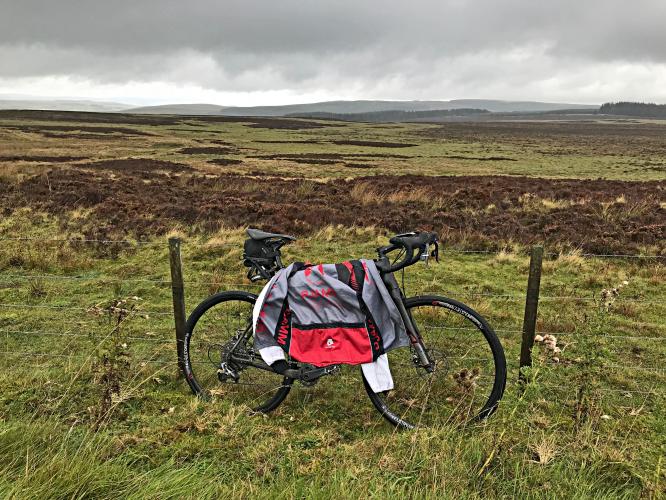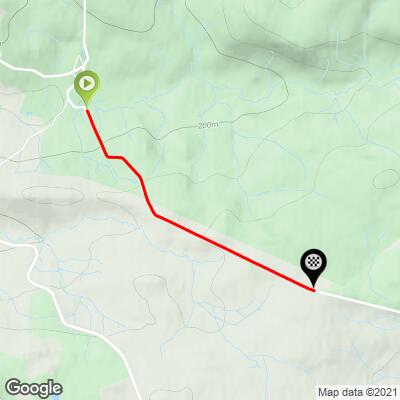![]()
Winter’s Gibbet hosted the British National Hill Climb Championships in 2004 (won by Jon Dayus).
![]()
This is a moderate distanced 100 Greatest Cycling Climbs ride at 3.4 kilometers with a mild grade throughout - averaging 4.7%. The rist third of the climb is the toughest at 7.4% followed by 900 meters at 1.6% (including two 200 meter descents). This is one of 2 GCC 100 climbs that end at a gallows (Combe Gibbet GCC #25 being the other) - we guess the objective of hanging back in the day was to make a point and dangling at the top of the hill certainly does that . . .(?)
![]()
![]()
A lot of straight on this climb - last 2 km arrow straight (2.5% for that segment).
The gibbet was used to hang William Winter after he murdered Margaret Crozier in August, 1791 in her home in Raw Pele near Elsdon (climb begins just outside Elsdon).
![]()
Steepest ½ kilometer begins at the very start of the climb (8.6%)
100HillsForGeorge.blogspot.com:
“Cheerfully named after the gibbet that was used to hang William Winter, this was my first climb back in England after all the Scottish climbs. I was hoping the “monster” climbs were over (ie that the really long climbs were done) and indeed this was a much shorter climb (and a mere 5/10 and not ending at a ski resort!).
Another absolutely beautiful ride though – just a quick cruise out and ramping up ahead was a nice straight slope which focussed the mind straight away.
Lots of shots of the sky on the video I’m afraid – the only thing I can think was the heat of riding was making me tip my helmet back to get some air on my hot head!
Again, having got rid of the steep stuff earlier on and the fact that the wind wasn’t TOO horrific, it was really a relatively gentle cruise up to the top, riding some lovely deserted roads and thoroughly enjoying the ride.
I do remember thinking to myself – living round here and riding these hills on days like this must be pretty nice…” More
Winters Gibbet is Simon Warren’s #61 and begins 200 meters south of the southern edge of Elsdon, Northumberland:
“Elsdon is a village and civil parish in the English county of Northumberland about 10 miles (16 km) to the southwest of Rothbury. The name is derived from the Old English meaning Elli's valley.
Formerly the capital of Redesdale, Elsdon contains a very fine example of a Motte and Bailey Castle, and a near perfect Pele Tower (fortified house of a type found in the border country) which is a private residence.
Geographically, Elsdon lies in Redesdale and, as a market town, was once the primary settlement in the area.
History
Elsdon has a grim reminder of the past in the gibbet that rears its gaunt outline on the hill known as Steng Cross. Strangely enough this gallows has no connection with the Border raiders, many of whom met their death "high on the gallows tree". The present gibbet stands on the site of one from which the body of William Winter was suspended in chains after he had been hanged at The Westgate in Newcastle. Today this grisly relic is called Winter's Gibbet. Pieces of the gibbet were once reputed to be able to cure toothache, if rubbed on the gums.
In 1791, a very nasty murder of an old woman, Margaret Crozier, took place. The following quote from Tomlinson's Guide to Northumberland shows the enjoyment which the old writers took in recounting horrors in all their bloodthirsty detail. Tomlinson says:
Believing her to be rich, one William Winter, a desperate character, but recently returned from transportation, at the instigation, and with the assistance of two female faws [vendors of crockery and tinwork] named Jane and Eleanor Clark, who in their wanderings had experienced the kindness of Margaret Crozier, broke into the lonely Pele on the night of 29th August 1791, and cruelly murdered the poor old woman, loading the ass they had brought with her goods. The day before they had rested and dined in a sheep fold on Whisker-shield Common, which overlooked the Raw, and it was from a description given of them by a shepherd boy, who had seen them and taken particular notice of the number and character of the nails in Winter's shoes, and also the peculiar gully, or butcher's knife with which he divided the food that brought them to justice.
The shepherd lad must have had very good eyesight to count the number of nails in Winter's shoes!
Present on the village green is a Pinfold, where stray livestock were kept in years past, pending the payment of a fine by their owners. Also present is the site of an old cockfighting ring and at the North end of the village green is a stone, which once held a ring to which bulls were tied for bull baiting. Up to the late 16th century, this was an almost lawless place, confirmed by the signs of these "pastimes" and the marks just inside the church where parishioners sharpened swords and arrowheads on the church pillars! Between the Motte & Bailey Castle and the Pele tower is some flat land known as the Haugh, where in antiquity, the men of Elsdon practised archery. This is not the countryside of Morris Dancers and Cricket, but an area, which remained beyond the law long after England and Scotland were settled, and in some ways this harshness and the lack of facilities are what has preserved Elsdon as a truly unspoilt Northumbrian Village.” Wikipedia - Elsdon, Northumberland
![]()
The climb is partially in Northumberland National Park :
“Northumberland National Park is the northernmost national park in England. It covers an area of more than 1,030 square kilometres (400 sq mi) between the Scottish border in the north to just south of Hadrian's Wall, and it is one of the least populated and least visited of the National Parks. The park lies entirely within Northumberland, covering about a quarter of the county.
The park covers several distinct areas. In the north are the Cheviot Hills, a range of hills that mark the border between England and Scotland. Further south, the hills give way to areas of rolling moorland, some of which have been covered by forestry plantations to form Kielder Forest. The southernmost part of the park covers the dramatic central section of Hadrian's Wall, dating from the Roman occupation.
The 10,000-year history of human habitation of the region is explored through the many archaeological sites, ranging from prehistoric monuments and Roman remains to Pele towers, constructed as a defence against Border Reivers.” Wikipedia - Northumberland National Park

 We've partnered with Sherpa-Map.com to bring you the best route planning tool. With a PRO Membership you can use this climb as a reference when creating your route.
We've partnered with Sherpa-Map.com to bring you the best route planning tool. With a PRO Membership you can use this climb as a reference when creating your route. 

